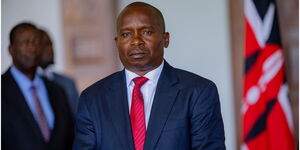Since his assumption of office in 2013, President Uhuru Kenyatta’s administration has been a beehive of activities that cut across all levels.
In the nine years that the Head of State has been at the helm, notable changes have been instituted including the overhaul of police uniforms as well as the country’s currency.
As President Uhuru Kenyatta’s term nears the end (eight months to be exact), here are the five major changes he made during his tenure.
Police Uniform
In 2018, the Ministry of Interior and Coordination of National Government, under the leadership of CS Fred Matiang’i, embarked on a major overhaul of the police uniform.
The state began the process of facing out the then ubiquitous sky blue shirts and navy blue trousers that were in use at the time for persian blue shirts and trousers with the side of the arms donning the word “POLICE” while retaining the blue, yellow, red strips of the police department.
At the time, President Uhuru Kenyatta explained that the new uniforms were to help in easy identification of police officers.
Besides the new uniforms, Uhuru merged the Regular and Administration Police (AP) services into a new unit referred to as the General Duty Officers (GD).
The new unit comprises 64,252 officers under the Deputy Inspector General (DIG) with the aim of enhancing security in the country.
The directive faced several hurdles including a court case filed by activist Okiya Omtatah. However, the transition has been realised.
- Money
In December of the same year, the Head of State embarked on a currency changing journey in an exercise aimed at getting rid of money launderers and corrupt individuals.
Officiating the launch of the new generation currency at the Central Bank of Kenya (CBK), the Head of State noted: "We shall be unveiling a set of new generation coins which are compliant with our 2010 Constitution. I am extremely pleased that today we can achieve another milestone."
"I am informed that the new generation coins continue the tradition of depicting an aspect that best describes our country," he added.
The exercise replaced the faces of politicians, that of the founding President Jomo Kenyatta and his successor Daniel Moi, with those of animals and the country’s iconic landmarks.
The new notes were also changed to display features that make them accessible to visually impaired people.
- Huduma Card
In 2019, the government announced that it intended to do away with the national Identification cards and replace them with Huduma Namba cards.
The government announced that the new cards would capture an individual's data including National Hospital Insurance Fund (NHIF) information to reduce the huge number of cards that are produced by various departments and organisations.
In October 2020, Uhuru became the first person to receive the Huduma Namba Card and the First Lady Margaret Kenyatta became the second. After that, the exercise was open to the public.
The next month, ICT Cabinet Secretary, Joe Mucheru, announced that the current card used as a National Identification document would cease operating on December 12, 2021.
The rollout of the card was, however, declared unconstitutional by the High Court in October 2021 for being in conflict with the Data Protection Act. The state had spent Ksh10 billion in the exercise.
As of October 2021, over 11.2 million Huduma Cards had been distributed countrywide.
- Competency Based Curriculum
In 2017, the Ministry of Education began the process of overhauling the Education system in the country from the then 8-4-4 to the Competency Based Curriculum (CBC) that is under rollout today.
The new system sought to reduce the years spent in Primary school from 8 to 6. It included 2 years of pre-primary education, 6 in primary, 3 years in junior secondary education, 3 years in senior secondary education and 3 years (minimum) in tertiary education.
The new system, however, attracted criticism from stakeholders and parents alike owing to its demanding schedule and high costs for the supplies to sustain student’s experiments.
Uhuru, in October 2021 clarified that the new system was here to stay and directed three ministries, Education under Cabinet Secretary, George Magoha, Interior led by CS Fred Matiang’i and Treasury under CS Ukur Yatani, to establish a framework for the construction of over 10,000 classrooms to facilitate the transition to secondary schools.
The rollout is currently in Grade 5 but a new lawsuit by a concerned parent threatens to derail its progress. The case filed by a parent, Esther Ang'awa, demanded that further implementation of the new system be halted and Justice Anthony Mrima agreed that she raised pertinent issues.
A three-judge bench is yet to hear the case.
- Introduced CAS Positions
President Uhuru Kenyatta, in 2018, expanded the government by creating 29 Chief Administrative Secretary (CAS) positions.
At the time of creation, Uhuru explained that individuals who occupy the CAS position would be responsible for helping the Cabinet Secretaries to better coordinate affairs in their respective ministries.
“I have decided to establish a new position in government, the position of Chief Administrative Secretary in all our ministries,” Uhuru stated at the time.
This role was likened to that of an assistant minister that was in the former constitution. However, this role was not defined in the Constitution of Kenya 2010.
In April 2021, High Court Judge Anthony Mrima, however, termed the positions unconstitutional noting that the law was not followed while they were being created.












